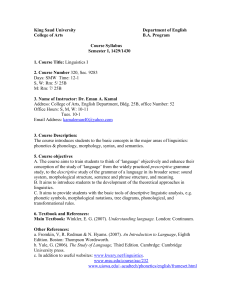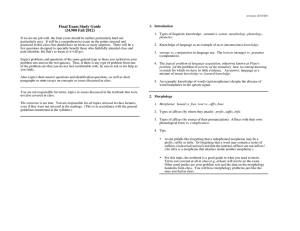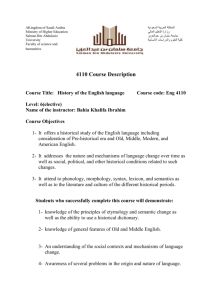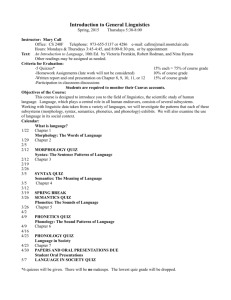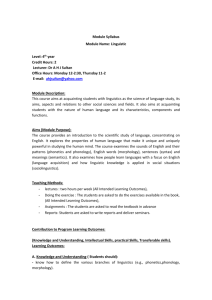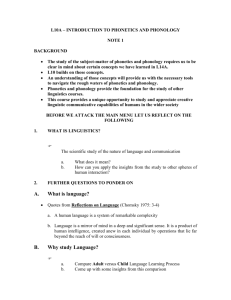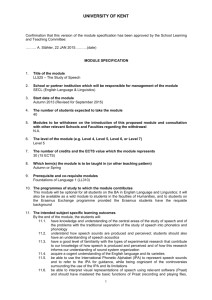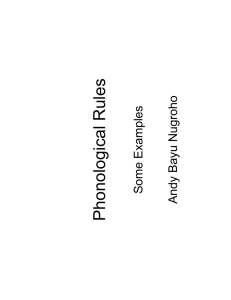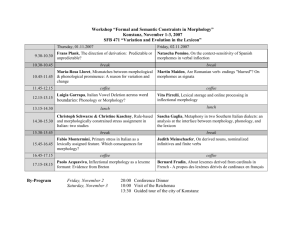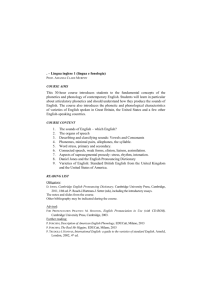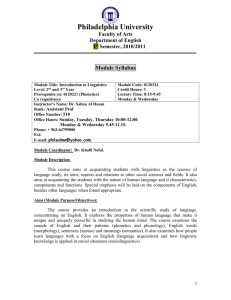LL310 - University of Kent
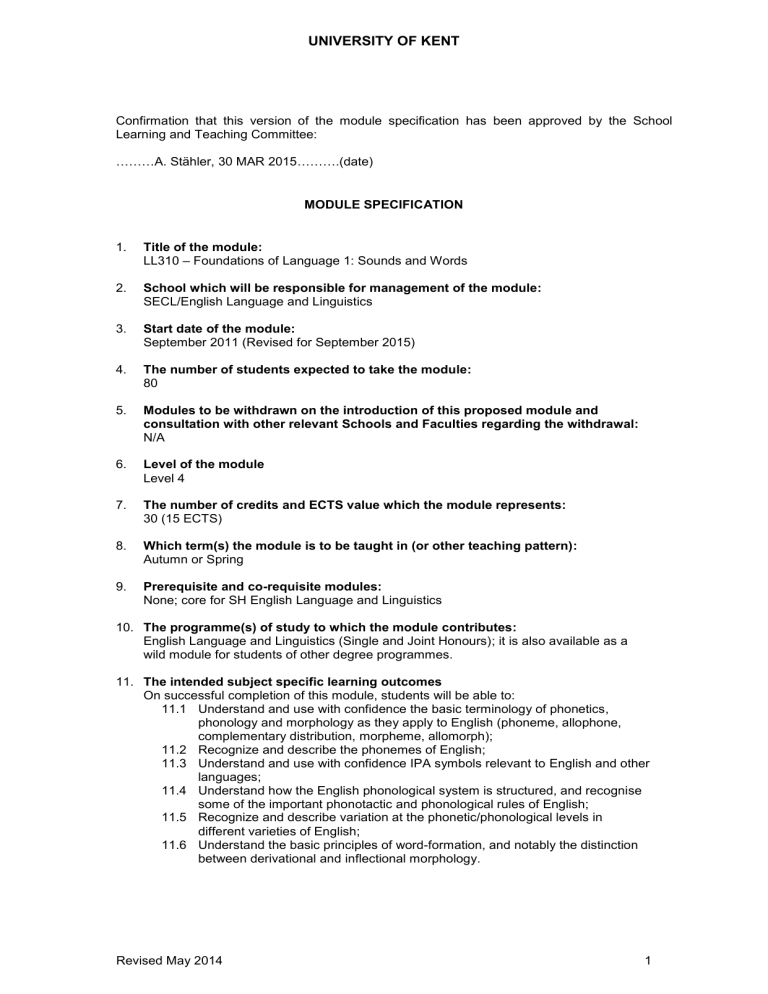
UNIVERSITY OF KENT
Confirmation that this version of the module specification has been approved by the School
Learning and Teaching Committee:
………A. Stähler, 30 MAR 2015……….(date)
MODULE SPECIFICATION
1. Title of the module:
LL310 – Foundations of Language 1: Sounds and Words
2. School which will be responsible for management of the module:
SECL/English Language and Linguistics
3. Start date of the module:
4. The number of students expected to take the module:
80
September 2011 (Revised for September 2015)
5. Modules to be withdrawn on the introduction of this proposed module and consultation with other relevant Schools and Faculties regarding the withdrawal:
N/A
6. Level of the module
Level 4
7. The number of credits and ECTS value which the module represents:
30 (15 ECTS)
8. Which term(s) the module is to be taught in (or other teaching pattern):
9. Prerequisite and co-requisite modules:
None; core for SH English Language and Linguistics
Autumn or Spring
10. The programme(s) of study to which the module contributes:
English Language and Linguistics (Single and Joint Honours); it is also available as a wild module for students of other degree programmes.
11. The intended subject specific learning outcomes
On successful completion of this module, students will be able to:
11.1 Understand and use with confidence the basic terminology of phonetics, phonology and morphology as they apply to English (phoneme, allophone, complementary distribution, morpheme, allomorph);
11.2 Recognize and describe the phonemes of English;
11.3 Understand and use with confidence IPA symbols relevant to English and other languages;
11.4 Understand how the English phonological system is structured, and recognise some of the important phonotactic and phonological rules of English;
11.5 Recognize and describe variation at the phonetic/phonological levels in different varieties of English;
11.6 Understand the basic principles of word-formation, and notably the distinction between derivational and inflectional morphology.
Revised May 2014 1
UNIVERSITY OF KENT
12. The intended generic learning outcomes
On successful completion of this module, students will be able to:
12.1 Communicate the results of study and work accurately, with well-structured and coherent arguments in an effective and fluent manner both in speech and in writing, to a specialist and non-specialist audience;
12.2 Develop their ability to work cooperatively with others, exercising personal responsibility and sensitivity;
12.3 Evaluate and interpret data logically and systematically;
12.4 Demonstrate their ability to undertake independent learning, by taking initiative, being organised and meeting deadlines;
12.5 Use IT skills to present information effectively; develop and exchange relevant information through the use of shared access to documents and web-based learning.
13. A synopsis of the curriculum
The module will begin by offering a basic introduction to the description of speech sounds, with emphasis on those used in English and detailed descriptions first of consonants, and then of vowels. The gaps between sound and orthography will be highlighted as the IPA (International Phonetic Alphabet) symbols are learned. The course will then move from phonetics (the study of speech sounds) to phonology (the study of the sound systems in language), focusing on the phonotactics (rules of co-occurrence) and general phonological rules of English. Students will use this knowledge to explore and describe different accents of English. From phonology, the module moves to morphology (the study of word-structure), highlighting the differences between derivational and inflectional morphology, and introducing analytical concepts such as the morpheme and allomorphy, and critically evaluating descriptive models such as word and paradigm, item-and-process and item-and-arrangement grammars.
14. Indicative Reading List
Blake, B. (2009) All About Language . Oxford: Blackwell.
Fromkin, V., Rodman, R. & Hyams, N. (2011 and previous editions). ‘Morphology: The words of language’ in An introduction to language . Boston: Wadsworth.
Ladefoged, P., & Johnson, K. (2011). A course in phonetics (Sixth edition.). Boston, MA:
Wadsworth/Cengage Learning.
Matthews, P. H. (1990) Morphology . Cambridge: Cambridge University Press.
McMahon, A. (2004) Introduction to English Phonology . Edinburgh: E.U.P.
Roach, P. (2001) Phonetics . Oxford: Oxford University Press.
15. Learning and Teaching Methods, including the nature and number of contact hours and the total study hours which will be expected of students, and how these relate to achievement of the intended learning outcomes.
Total Contact Hours: 30
Independent Study Hours: 270
Total Study hours: 300
This module will be taught in two weekly sessions, consisting of one 1-hour long lecture and one 2-hour long seminar for ten weeks. The lecture will address key concepts of phonetics, phonology and morphology of English and its regional varieties (learning outcomes 11.1-6), while the seminars will provide for practical investigations of the topics introduced in the lectures (learning outcomes 11.1-6 and 12.1-2). Study hours will be spent on activities such as reading in the library and online (learning outcomes 11.1-6,
12.3-4) and preparing seminar presentations (learning outcome 12.5).
16. Assessment methods and how these relate to testing achievement of the intended learning outcomes
100% Coursework:
Online test (phonetics/phonology): 40% (90 min)
Group Presentation:
In-class test:
20% (15 min)
40% (60 min)
Revised May 2014 2
UNIVERSITY OF KENT
The Online test will test learning outcomes: 11.1-5, 12.3-5
The Group Presentation will test learning outcomes: 11.1-6, 12.1-2 & 4-5
17. Implications for learning resources, including staff, library, IT and space
None
The In-class test will test learning outcomes: 11.1-6, 12.1, 3-4
18. The School recognises and has embedded the expectations of current disability equality legislation, and supports students with a declared disability or special educational need in its teaching. Within this module we will make reasonable adjustments wherever necessary, including additional or substitute materials, teaching modes or assessment methods for students who have declared and discussed their learning support needs. Arrangements for students with declared disabilities will be made on an individual basis, in consultation with the
University’s disability/dyslexia support service, and specialist support will be provided where needed.
19. Campus(es) where the module will be delivered
Canterbury
Revised May 2014 3

